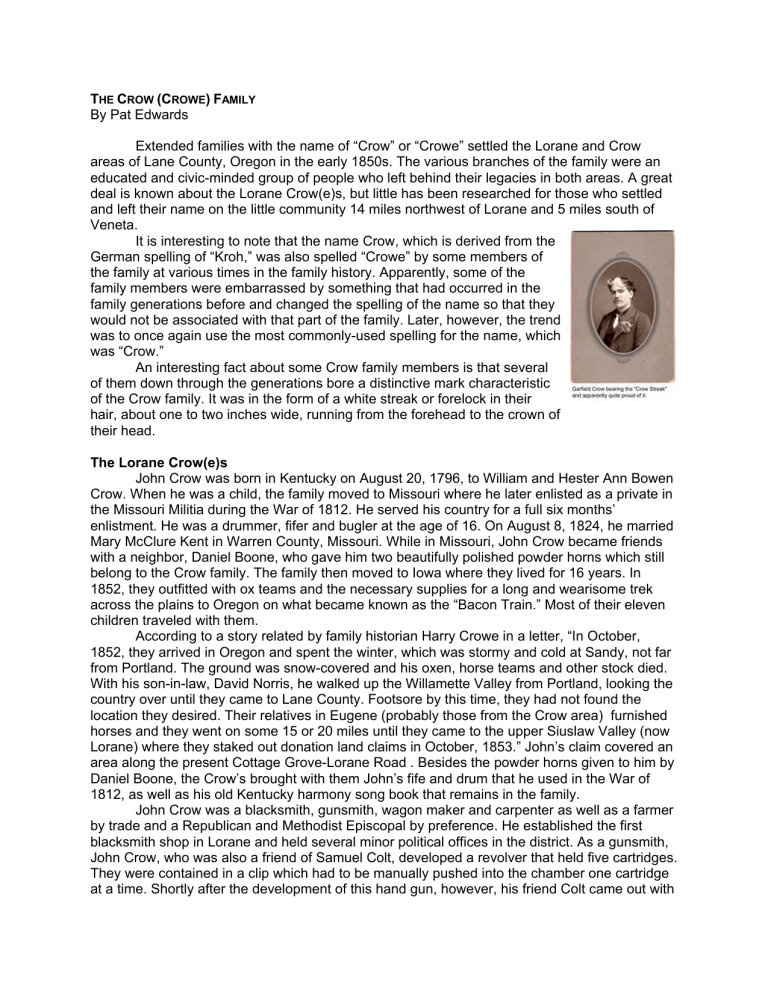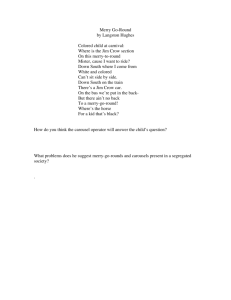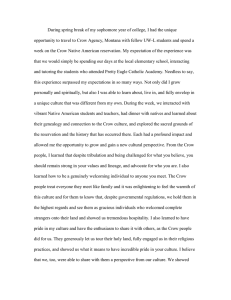
THE CROW (CROWE) FAMILY By Pat Edwards Extended families with the name of “Crow” or “Crowe” settled the Lorane and Crow areas of Lane County, Oregon in the early 1850s. The various branches of the family were an educated and civic-minded group of people who left behind their legacies in both areas. A great deal is known about the Lorane Crow(e)s, but little has been researched for those who settled and left their name on the little community 14 miles northwest of Lorane and 5 miles south of Veneta. It is interesting to note that the name Crow, which is derived from the German spelling of “Kroh,” was also spelled “Crowe” by some members of the family at various times in the family history. Apparently, some of the family members were embarrassed by something that had occurred in the family generations before and changed the spelling of the name so that they would not be associated with that part of the family. Later, however, the trend was to once again use the most commonly-used spelling for the name, which was “Crow.” An interesting fact about some Crow family members is that several of them down through the generations bore a distinctive mark characteristic of the Crow family. It was in the form of a white streak or forelock in their hair, about one to two inches wide, running from the forehead to the crown of their head. The Lorane Crow(e)s John Crow was born in Kentucky on August 20, 1796, to William and Hester Ann Bowen Crow. When he was a child, the family moved to Missouri where he later enlisted as a private in the Missouri Militia during the War of 1812. He served his country for a full six months’ enlistment. He was a drummer, fifer and bugler at the age of 16. On August 8, 1824, he married Mary McClure Kent in Warren County, Missouri. While in Missouri, John Crow became friends with a neighbor, Daniel Boone, who gave him two beautifully polished powder horns which still belong to the Crow family. The family then moved to Iowa where they lived for 16 years. In 1852, they outfitted with ox teams and the necessary supplies for a long and wearisome trek across the plains to Oregon on what became known as the “Bacon Train.” Most of their eleven children traveled with them. According to a story related by family historian Harry Crowe in a letter, “In October, 1852, they arrived in Oregon and spent the winter, which was stormy and cold at Sandy, not far from Portland. The ground was snow-covered and his oxen, horse teams and other stock died. With his son-in-law, David Norris, he walked up the Willamette Valley from Portland, looking the country over until they came to Lane County. Footsore by this time, they had not found the location they desired. Their relatives in Eugene (probably those from the Crow area) furnished horses and they went on some 15 or 20 miles until they came to the upper Siuslaw Valley (now Lorane) where they staked out donation land claims in October, 1853.” John’s claim covered an area along the present Cottage Grove-Lorane Road . Besides the powder horns given to him by Daniel Boone, the Crow’s brought with them John’s fife and drum that he used in the War of 1812, as well as his old Kentucky harmony song book that remains in the family. John Crow was a blacksmith, gunsmith, wagon maker and carpenter as well as a farmer by trade and a Republican and Methodist Episcopal by preference. He established the first blacksmith shop in Lorane and held several minor political offices in the district. As a gunsmith, John Crow, who was also a friend of Samuel Colt, developed a revolver that held five cartridges. They were contained in a clip which had to be manually pushed into the chamber one cartridge at a time. Shortly after the development of this hand gun, however, his friend Colt came out with his famous Colt .45 revolver which automatically turned and fed a new cartridge into the chamber after each shot. Crow bowed to the superior invention of his friend. I won’t relate the whole Crow family history on these pages, but stories about some of the more colorful members of the family ensue... Richard “Dick” and Sarah Crow didn't arrive in Oregon until February 25, 1853. He was awarded his 161-acre donation land claim in the Siuslaw Valley on December 21, 1854. This claim was located along Siuslaw River and Fire roads. He built his original home on the current Royce property where he ran a small brick yard. Dick and Sarah had 15 children of their own, and a granddaughter that they raised. On Sundays, Sarah, known as “Aunt Jane,” dressed each one of their children in their best clothes and mounted them on horseback. Then she put the two smallest babies into a basket and, riding sidesaddle, took them all to Sunday School at the Methodist Episcopal Church in Lorane. Benjamin Franklin Crow, or Frank as he was called, came to the Siuslaw Valley with his parents in 1852. He homesteaded on a place located near his brother Thomas’s donation land claim. According to legend, Frank Crow and Ellen Wingard courted each other for some time. About the time the courtship began, Mr. Crow’s mare had a colt. It is said that the colt died of old age before the courtship was ended. It seems that the couple had differing political views and both were too stubborn to change. Neither ever married. Another story told about Frank Crow was included in a news article written about J.M. Nighswander who lived in Hadleyville, situated between the communities of Lorane and Crow. Nighswander “laughs at the stir his ear tube rig caused at a July 4th celebration at Lorane in 1902. Old man Frank Crow was one of those who didn’t think a machine could talk. After listening on it he (Crow) laid down the tubes and with cane uplifted, ran around a nearby tree ready to strike the smart-aleck trying to fool him. Nobody there. The phonograph had arrived.” William Nathan Crow was 12 years old when the family headed across the plains. He received a good education by attending public school in Eugene, Oregon, and later taking a course at a commercial college in Portland. After completing the course, he taught at several schools in Oregon until he married Lillie S. Harris on April 7, 1883, and settled on a portion of his father’s farm in the Siuslaw Valley. William, or “Bubb” as he was called, was the first postmaster of Lorane, and his wife Lillie was the person responsible for naming the community “Lorane.” William was a farmer who raised fine Shorthorn cattle on his 400-acre property. He was also a skilled blacksmith, wagonmaker and carpenter and loved to play tunes on his dulcimer. He served Lane County as a justice of the peace for several years and was a member of the Republican Party. Lillie was a staunch Methodist and was active in the local church. They had four children, Elza H. (Harry), Elmer, Oral and Pearl. William and Lillie’s son, Elmer, married Della Sharp. He was a justice of the peace in the Lorane area and ran a threshing machine during the late summer months. He also owned and operated the E.R. Crowe Oregon Fir Lumber Co. in Lorane for a number of years. Elmer was a graduate engineer with a degree from Oregon State College. He was known to have designed many implements which were adapted for use in his own businesses and in the Lorane Valley Orchard. Della Crowe served as a 4-H Club leader during the time that they lived in Lorane. They lived, with their daughters, Lala and Lorna, for 18 years on a farm located on Cottage Grove-Lorane Road on a hill east of the present Duane Doughty residence. Another son of William Nathan Crow, Oral E. Crowe, owned and operated the O.E. Crowe General Store that was located in the lower level of the Lorane I.O.O.F. Lodge building. He and his brother, Elmer, also ran the Crowe Brothers Cheese Factory, also known as the Lorane Cooperative Cheese Co., in the early 1900s. Oral Crowe served as the Lane County Court Commissioner from 1924 to 1935. He was appointed to the post initially to finish the term of a recalled commissioner and was later elected to the position. There was an interim period between 1924 and 1935, when he temporarily lost the commissioner’s seat in an election. Crowe was also named the Lane County Sheriff Pro-Tem from about 1942 until 1945. When the regular Lane County Sheriff, Tom Swarts, joined the war effort and was sent overseas, Crowe was appointed to perform the duties of the sheriff until Swarts’ return in about 1945. A story is told about Oral by his son, Duane. Apparently, Oral Crowe was not a farmer at heart. In the earlier part of his life, he farmed only in order to add to the family income and food supply – not because of any special love of the land. He frequently complained about the poor soil in his fields and a favorite saying of his was, “This soil is so bad that a man couldn’t raise Hell on it with seven naked ladies and a barrel of whiskey!” One day James Chapman, the mail carrier from Cottage Grove (and Crowe's father-inlaw), stopped at the Crowe home with a letter notifying Crowe that he had been appointed to the Lane County Commissioner’s post. Oral was in one of his fields some distance from his house, doing some plowing. Chapman decided that the registered letter was important enough to handdeliver to Crowe in the field. Upon seeing Chapman approach with the letter in his hand, Oral removed the long reins from over his shoulder, dug out his pocket knife with which to open the letter, and calmly proceeded to read the news that he was the new Lane County Commissioner. Crowe picked up the reins and threw them with all of his might over the heads of his team. He all but danced his way back to the house leaving the team standing in the middle of a furrow. He never went back to farming after that day. Chapman, in the meantime, was left to bring home the team of horses and the plow. The mail was rather late that day for those on the remainder of his route. More on the Crow(e) family of Lorane can be found in the pages of Sawdust & Cider; A History of Lorane, Oregon and the Siuslaw Valley (1987) or its most recent major revision, From Sawdust & Cider to Wine; A History of Lorane, Oregon and the Siuslaw Valley (2006); http://www.sawdustandcider.com. The Crow Crow(e)s Other than census data, little is known of the Crow families that first settled the Crow, Oregon area of Lane County, Oregon. We do know that the “Crow Crows” were related to the “Lorane Crows.” Andrew Jackson Crow, who is most probably the man the area is named for, was the son of Lewis Crow, brother of William Crow, whose son, John, settled in the Lorane area of the Siuslaw Valley. All descended from Johannes Gottfried Kroh, a German immigrant who settled in Kentucky in the mid-1700s. He and his wife, Barbara, also lived in Pennsylvania and later, St. Charles County, Missouri where he died. Four of Lewis Crow’s offspring (William, George, Andrew Jackson, and Catherine Crow) moved to Oregon during the mid-1800s, as all are listed in death records in various parts of Oregon. Andrew Jackson Crow settled in Lane County between 1850 and 1860. He and his family were listed in the 1860, 1870 and 1880 U.S. federal censuses as living in “South Eugene City” or “Eugene Township Precinct” since there was never a Crow area post office established. In trying to determine whether I had found the correct Crow for the area, I check neighbors who lived on farms near him on the census sheets. Names included those of Hadley, Criswell, Heatherly (Hetherly), Richardson, McCullouch (McCulouch), McDaniel and Coleman (Colman) – all familiar to the area – although spellings were somewhat off in a few cases. Other names of some of the larger families which I didn’t immediately recognize (but others may) are: Chapman, Christensen, Allen, Chick, Rush, Bailey, Ware, McCullen (McCollum), Swift and Andrews, among others. One name, which appears to be Thomas Sheats, was listed as a school teacher, probably one of the area’s first. Andrew Jackson Crow arrived in the area, 5 miles south of Veneta, Oregon, that bears his name between 1850 and 1860. He was born June 6, 1808 in Flint Hill, St. Charles County, Missouri, to Lewis Crow and Susan Zumwalt (another familiar name in the area). His first wife, Christina Zumwalt died in 1852 while on the Oregon Trail. In genealogical records, her place of death is listed as “Oregon Trail at the Snake River Crossing, Oregon.” They had 10 children (Ellen Frances, Cynthia Elizabeth, Sarah Susanna, William Marion, James Andrew, Mary Jane, Lucinda, John L., Lodema, and Rosanna Amanda). After his arrival in Lane County, Oregon, Andrew married Mary (either Taylor or Sanders) in 1856. The couple had four more children, Nancy M., Malvina, Thomas, and Margaret. On the 1860 census, only James, John, Thomas, Lodema, Amanda and Malvina Crow and William and John Sanders (probably Mary’s children from a previous marriage) were listed with the family grouping. Because of the closeness of the Hadley family on the listings on the 1860 census sheets, it appears that the Crow family lived east of the community of Crow, somewhere between Doane and Briggs Hill Roads. The community of Hadleyville sat at the juncture of Territorial Road and Briggs Hill Roads near where the Hadley family lived. Andrew was listed as a farmer and Mary as a housewife. The 1870 census listed neighbors of Mulkey, Barger, Bailey, Morgan, Calloway, Ware, McCollum, Hemenway, Jenkins, Richardson, Purkerson, Fisher, Andrews, Fisk, Gibson, Zumwalt, among others. By then, William Crow and James Crow, Andrew’s sons, had established their own families and households. William’s wife was listed as Mary Jane and their children, Albert and Franklin. James Crow’s wife was Hellen and they had 2 children, Lewis and Cynthia. The 1880 census lists the Andrew Crow and James Crow families, but apparently William had left the area. Neighbors included the Sanders, Jenkins, Richardson, Thompson and Hamilton families among others. Andrew and Mary Crow left the area sometime after 1880, probably to join other family members, specifically his older brother William, in the northeastern part of Oregon. He died on December 13, 1891 in Heppner, Morrow County, Oregon.




